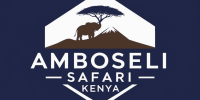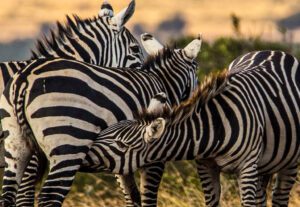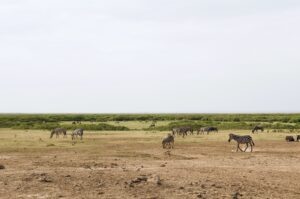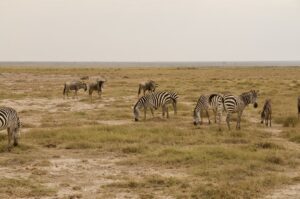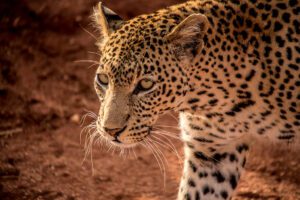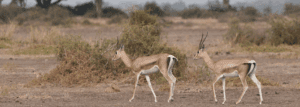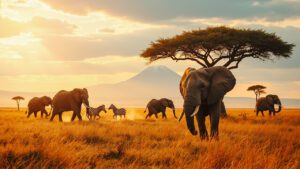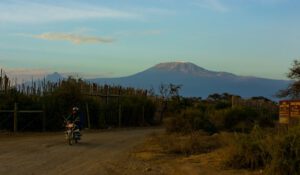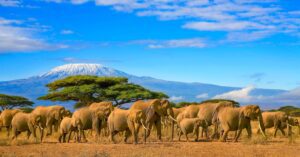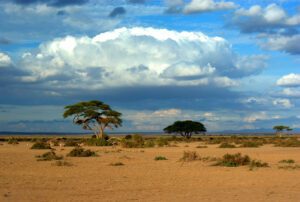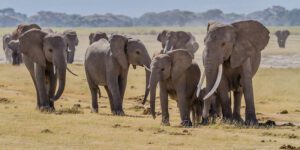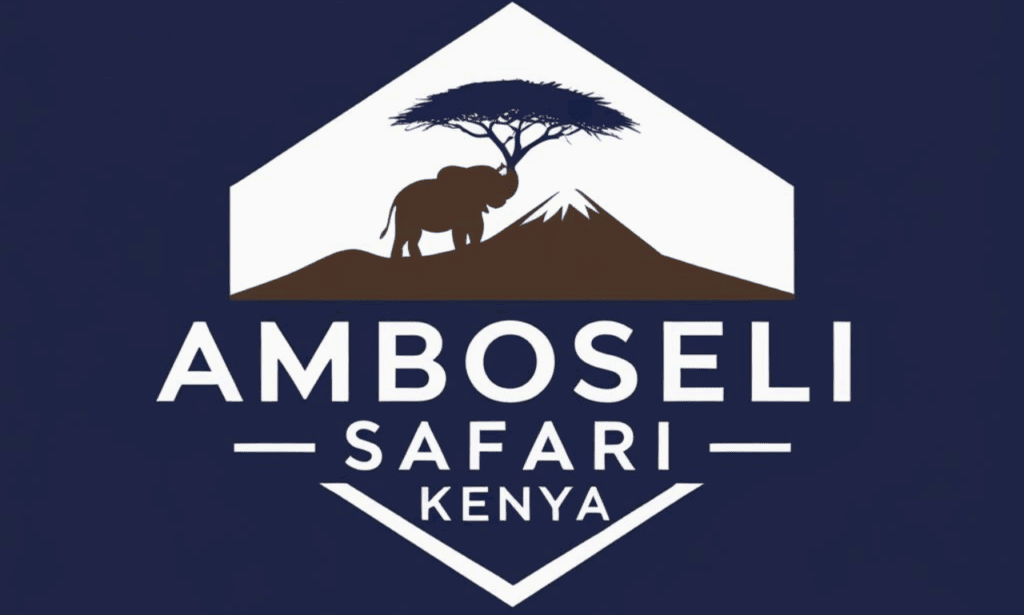What is Sinet Delta Amboseli, and where is it located?
Sinet Delta Amboseli refers to a unique geographical area located near or within the larger Amboseli region in southern Kenya, close to the border with Tanzania. Amboseli is well-known for its breathtaking views of Mount Kilimanjaro and is home to Amboseli National Park, one of Kenya’s most famous wildlife reserves. While not as widely recognized as the national park itself, Sinet Delta is thought to be a part of this ecosystem that plays a significant role within the larger Amboseli environment, which is rich in diverse wildlife and national park attractions.
The term “delta” generally signals the presence of water, like river systems flowing into wetlands or low-lying areas, making Sinet Delta particularly important in the dry, semi-arid landscape of Amboseli National Park. Despite the surrounding areas being dry, the delta could indicate a highly productive, water-rich ecosystem, serving as a haven for plants, animals, and possibly local communities, including those involved in Maasai culture.
For context, Amboseli is world-famous for its wide-open savannahs, stunning landscapes, and incredible biodiversity, especially the African elephants roaming with Mount Kilimanjaro in the background. Sinet Delta likely fits within this special area and has its role in supporting local biodiversity and communities, enhancing the safari experience for visitors exploring Amboseli National Park.
What makes Sinet Delta Amboseli significant or unique?
Sinet Delta Amboseli is likely unique because it offers both water and shelter in an otherwise dry and challenging environment. Across much of Amboseli National Park, the ecosystem faces dryness for most of the year, with occasional rains transforming the landscape into temporary wetlands. Sinet Delta, on the other hand, may provide a more reliable presence of water compared to other parts of the Amboseli National Park attractions.
Water sources like deltas are life-giving in semi-arid areas. They create green, fertile areas filled with plants, which then attract herbivores looking for food and predators following their prey. If Sinet Delta holds some of the few consistent sources of water in the Amboseli region, it would be extremely vital not just for animals but also for the Maasai culture who live in the area. These communities often depend on such ecosystems for grazing their livestock and meeting their own water needs.
The uniqueness may also relate to the connectivity within the broader Amboseli system. Amboseli’s diverse wildlife relies on movement corridors as they migrate throughout the year in search of food, water, and safe areas to raise their young. Sinet Delta might act as a key rest stop or refuge during these journeys. For example, African elephants, known to traverse massive distances, could use this area to cool off and drink water when other waterholes have dried up. This special role makes the delta stand out as more than just another patch of land, it becomes a crucial piece of a bigger ecological puzzle.
What kind of environment or ecosystem characterizes the area?
The ecosystem of Sinet Delta Amboseli is likely a mix of wetlands, grasslands, and possibly woodlands, depending on its exact nature and size. In general, wetlands are characterized by an abundance of water, which supports lush vegetation such as reeds, grasses, and aquatic plants. Around the edges of the wetland area, there may be forests or savannah-like ecosystems where animals graze or take cover under larger trees, making it an ideal spot for wildlife viewing.
As part of the larger Amboseli National Park, this area typically experiences a semi-arid climate with relatively low rainfall for much of the year. However, deltas and wetlands are different. These are special parts of the land where water collects and remains, sometimes from underground springs or seasonal rivers. This unique feature allows the delta to support ecosystems that look much greener compared to the surrounding dry savannah grasslands.
The plants found in such an area would vary but may include tall papyrus, lush grasses, or shrubs that thrive in wetter conditions. These create diverse habitats that attract numerous bird species like herons, kingfishers, and egrets. Furthermore, this ecosystem is likely teeming with life, providing sustenance for herbivores such as zebras, African elephants, or gazelles, and predators like lions or leopards that naturally follow the herbivores, enriching the Amboseli National Park attractions.
Wetlands also act like environmental sponges. They store water and release it slowly into the surrounding areas, helping regulate flooding and providing a steady flow even during dry months. This ecological balancing act makes Sinet Delta a critical part of its regional ecosystem in Amboseli. For people and wildlife, it quite literally is a lifeline in an otherwise tough environment.
What wildlife or biodiversity is found in Sinet Delta Amboseli?
Sinet Delta Amboseli is home to a rich and diverse array of wildlife, making it an important ecological hub. This area is particularly well-known for supporting iconic African wildlife species, including elephants. Amboseli elephants are famous worldwide for their relatively large population, unique migration patterns, and their close association with the Amboseli ecosystem. These elephants rely on areas like Sinet Delta for food, water, and safe migratory spaces, contributing to the overall appeal of Amboseli National Park attractions.
Apart from elephants, the delta is also home to lions, cheetahs, zebras, giraffes, and buffalo, which roam the open savannah grasslands. Smaller mammals, such as warthogs, hyenas, and jackals, are common too. The birdlife in Sinet Delta is especially spectacular, serving as a habitat for more than 400 species of birds, including flamingos, herons, egrets, and storks that frequent various water sources, further enhancing the wildlife viewing experience.
The biodiversity of the Sinet Delta isn’t limited to large mammals or birds, it also includes numerous reptiles like crocodiles, snakes, and lizards that thrive in the semi-aquatic areas of the delta. Insects, essential for pollination and as part of the food chain, also play a significant role in maintaining the ecosystem’s balance, showcasing the intricate ecology of this area.
The unique mix of wetland and savanna habitats at the delta contributes significantly to the biodiversity. These environments allow species that depend on water, such as hippos, to thrive alongside animals that prefer drier grasslands, like wildebeests. This coexistence is why the area is considered so ecologically important, making it a must-visit for those looking to explore Amboseli National Park.
Examples of this biodiversity can be seen during the dry season. During this time, animals migrate to water sources in the delta, making it a congregational hotspot for wildlife enthusiasts. In short, Sinet Delta Amboseli serves as a vital life-supporting environment for both resident and migratory species, solidifying its status as a premier safari destination in Africa.
How is the region connected to Amboseli National Park?
Sinet Delta Amboseli is closely linked to Amboseli National Park attractions both ecologically and geographically. Amboseli National Park is a well-known wildlife reserve in Kenya, famous for its open savannah grasslands, majestic views of Mount Kilimanjaro, and its large elephant herds. This national park serves as a significant part of the broader Amboseli ecosystem, acting as a crucial habitat that supports diverse wildlife, including the iconic African elephants.
Wildlife in Amboseli National Park often migrates to and from the delta area depending on the seasons and availability of water and food. During the dry seasons, when water sources within the national park are scarce, animals like elephants, zebras, and antelopes move toward the lakebeds and wetlands in regions like Sinet Delta to sustain themselves. This natural movement showcases the interdependence of these landscapes in the context of the safari experience.
Additionally, the Delta plays a role in replenishing some of the smaller water catchment areas in Amboseli. Benefiting from underground springs fed by the melting glaciers of Mount Kilimanjaro, this water flows into surrounding regions, including parts of Amboseli National Park. This connection allows the park’s wildlife to survive the harsh dry periods, reinforcing its status as one of the premier safari destinations in Africa.
Another connection is through conservation corridors. Wildlife corridors allow animals to roam freely between Sinet Delta and Amboseli National Park without getting trapped by human activities or settlements. These corridors are crucial for maintaining genetic diversity among animals and ensuring their survival in the long term, thus enhancing the park’s appeal for wildlife viewing.
In short, Amboseli National Park and Sinet Delta work together as part of a wider system. Protecting one helps protect the other because they share the same water sources, wildlife populations, and ecological challenges. Together, they form a harmonious and interlinked landscape that is vital for both conservation and tourism.
What are the key challenges or threats facing the Sinet Delta Amboseli area?
Sinet Delta Amboseli faces numerous challenges and threats that endanger its environment and the wildlife living there. One major issue is habitat destruction due to human activities. As the local population grows, there is increasing demand for land for agriculture, settlements, and infrastructure development. These activities encroach on wildlife habitats, forcing animals into smaller areas and sometimes leading to human-wildlife conflicts, which can impact the safari experience in Amboseli National Park.
Water scarcity is another serious problem, especially during prolonged droughts, which are becoming more frequent and severe due to climate change. The delta’s water sources, which are critical for both wildlife and human communities, are drying up at alarming rates. When water becomes scarce, competition increases, sometimes leading to conflicts between herders who need water for their livestock and wildlife that rely on the same resources, affecting the overall wildlife viewing experience.
Another threat is poaching and illegal wildlife trade. While some species, like elephants, are protected, they are still targeted for their ivory. Poaching undermines conservation efforts in the area and reduces animal populations, which is detrimental to Amboseli National Park attractions.
Overgrazing by livestock also poses a threat to the delicate ecosystem of Sinet Delta. With local communities depending heavily on pastoralism, excessive grazing can deplete vegetation that wildlife relies on for food. This can further lead to soil erosion, degradation of the land, and long-term damage to the ecosystem, which is crucial for sustaining African wildlife.
Climate change adds a layer of uncertainty, altering rainfall patterns and making the area more prone to extreme conditions like droughts and floods. These changes disrupt migratory patterns and food availability for wildlife.
Additionally, poorly regulated tourism can harm the environment. While tourism plays a key role in funding conservation, too many vehicles and human activity can disturb animal behaviors and damage sensitive areas like wetlands, which are vital for the diverse wildlife present in the park.
Combating these threats requires collaborative efforts among governments, conservation organizations, and local communities to ensure Sinet Delta Amboseli remains a thriving ecosystem for future generations, preserving its role as a premier destination for Kenya safaris.
Are there any conservation efforts or organizations working in Sinet Delta Amboseli?
Conservation efforts in areas like Sinet Delta Amboseli often focus on preserving its delicate ecosystem, protecting its abundant wildlife, and sustaining the livelihoods of local communities. While specific organizations working in this area may vary, such efforts are generally tied to broader conservation goals within the greater Amboseli National Park, a key wildlife habitat in Kenya. For example, organizations such as the Big Life Foundation and the Kenya Wildlife Service (KWS) have been known to work in and around Amboseli areas, including places like Sinet Delta, which is renowned for its diverse wildlife and scenic beauty.
These conservation groups typically focus on addressing challenges like habitat degradation, human-wildlife conflict, poaching, and climate change. For instance, the Big Life Foundation has implemented innovative programs such as involving local rangers in anti-poaching efforts and establishing community-based initiatives to help locals coexist peacefully with wildlife. Such initiatives contribute to the overall safari experience in Amboseli National Park, where visitors can explore the vast savannah grasslands and encounter various wildlife species.
Sinet Delta Amboseli’s wetlands, which are critical for biodiversity, are a priority for restoration and protection. Conservation organizations often work to ensure water flow into the delta is maintained, as water scarcity due to climate change and human consumption poses significant challenges. The health of these wetlands is essential for the numerous aquatic birds and other fauna that inhabit the area, enriching the Amboseli National Park attractions.
Additionally, conservation success often depends on partnerships between governments, international NGOs, and local communities. Campaigns for reforestation or sustainable grazing practices might form part of their activities. Examples include tree-planting initiatives and promoting eco-tourism, which not only conserve habitats but also help generate income for local people, enhancing the overall ecology of Amboseli National Park.
What role does the local community play in preserving the Sinet Delta Amboseli ecosystem?
Local communities play a huge role in conservation because they live in and around the Sinet Delta and interact with the ecosystem daily. Many wildlife areas, including Amboseli National Park attractions, overlap with places where people live, farm, or herd livestock. This means that how the local community behaves directly affects the health of the environment.
One of their major contributions is participating in community-driven conservation programs. For instance, locals often work as wildlife rangers to protect animals from poaching and provide surveillance for illegal activities. These individuals use their knowledge of the land to monitor behaviors and support sustainable resource use while earning an income in the context of Kenya safaris.
Another important role is reducing human-wildlife conflict. In regions like this, people’s crops or livestock might be in danger because of wildlife such as elephants or lions. Local communities can build protective barriers, use innovative tools (like flashlights or electric fences), or adopt grazing methods that reduce competition between livestock and wild herbivores, ensuring a balance in the vast savannah grasslands.
In addition, traditional knowledge is invaluable. Indigenous communities often have insights about the environment, like when water sources are full or how seasons affect migrations, that contribute to modern conservation science. Educating younger generations about these traditions ensures this knowledge remains alive and supports the preservation of African wildlife.
Finally, local communities are key for promoting eco-tourism. When a local guide leads a safari or runs a cultural experience for visitors in the Amboseli region, they provide an economic incentive to keep the environment pristine. For example, a family operating a guesthouse near the delta benefits directly if tourists visit a thriving ecosystem, enhancing their safari experience.
Does the area have any cultural, historical, or economic significance?
Yes, the Sinet Delta Amboseli area has cultural, historical, and economic value, particularly for the Maasai community, who have historically lived in the Amboseli region. Culturally, this area represents a deep connection between the Maasai people, their traditions, and the land. The Maasai are known for their semi-nomadic lifestyle, which depends on livestock like cattle, goats, and sheep. The ecosystem, including the Sinet Delta’s wetlands and grasslands, has been integral to their way of life, providing water and pasture for animals. Ceremonies and cultural practices often revolve around nature, symbolizing their connection to the land.
Economically, the delta supports multiple livelihoods. Apart from livestock grazing, eco-tourism forms a major pillar for generating income in the region. Many visitors are drawn to Amboseli National Park attractions and its surrounding areas to witness diverse wildlife, including the majestic African elephants, lions, and flamingos. The Sinet Delta, being part of this wider ecosystem, benefits from people seeking serene landscapes and vibrant biodiversity. This tourism creates jobs, from running lodges and safari experiences to guiding tourists and selling local crafts.
Historically, the Sinet Delta, like the larger Amboseli area, has played a role in human-wildlife interactions for centuries. Ancient migration routes of both animals and humans passed through here, and the environment continues to be shaped by these longstanding patterns. Places like this are a living archive of how people have adapted to changing environments over time.
In essence, Sinet Delta Amboseli isn’t just an ecological space, it represents a merging of nature, culture, and economic opportunity, making it vital both locally and nationally.
How does climate change affect Sinet Delta Amboseli and its surroundings?
Climate change has a significant impact on Sinet Delta Amboseli and its surroundings, as it does on many ecosystems around the world. To understand how climate change affects this area, consider that Sinet Delta Amboseli is part of a fragile, semi-arid region in Kenya, closely tied to the greater Amboseli ecosystem and influenced by weather patterns, rainfall, and temperature changes. This unique area is renowned for its amboseli national park attractions, making it vital to grasp how climate change disrupts these natural cycles, causing several cascading effects.
For example, rainfall patterns in the region have become less predictable due to global warming. In the past, the area relied on relatively regular rains to sustain its wetlands, vegetation, and groundwater levels. Now, these rains may come too late, too early, or sometimes not at all. This leads to prolonged droughts in one year and severe flooding in another. Both droughts and floods are detrimental to local wildlife, vegetation, and the human communities that depend on this environment for survival, particularly affecting the diverse wildlife that thrives in Amboseli, including the iconic African elephants.
Droughts are especially harmful to the animals in the Amboseli ecosystem, such as elephants, zebras, and wildebeests, which rely on sufficient water and vegetation to survive. Without adequate rain, food and water sources dry up, causing animals to migrate farther than usual, sometimes into dangerous human settlements. Prolonged droughts can also weaken animals, leading to higher mortality rates. On the other hand, sudden heavy rains or floods can wash away plant life and erode the soil, leaving behind poor growing conditions even after water levels recede, affecting the safari experience for visitors hoping to see these magnificent creatures.
The rising temperatures associated with climate change also increase evaporation rates in wetlands and water bodies like the ones found in the delta. So even when water is available, it disappears faster than before. This affects not only wildlife but also local communities who depend on the Sinet Delta for freshwater, agriculture, and livestock farming.
In short, climate change disturbs the delicate balance in the Sinet Delta Amboseli ecosystem, threatening its long-term health and sustainability. Addressing these issues requires improved conservation practices, international climate action, and involvement of local communities to adapt and mitigate the impacts of climate change.
Are there any tourism opportunities or activities in Sinet Delta Amboseli?
Yes, there are promising tourism opportunities and activities in Sinet Delta Amboseli because of its location and connection to the larger Amboseli ecosystem. Amboseli is a world-renowned safari destination, famous for its incredible wildlife, stunning landscapes, and views of Mount Kilimanjaro. Visitors are particularly drawn to its elephants, which are some of the largest in Africa and are easy to spot on the open savannah grasslands. The Sinet Delta is an integral part of this ecosystem and offers its own unique attractions, making it a key spot to explore Amboseli National Park.
Tourists to Sinet Delta Amboseli can engage in activities such as game drives, birdwatching, and cultural tours. Game drives allow visitors to explore the area by vehicle, spotting iconic animals like lions, giraffes, zebras, and elephants. These drives also bring visitors close to the delta’s lush wetlands, which serve as an oasis of life for smaller creatures and migrating birds, enhancing the overall safari experience.
Birdwatching is another consistent draw for nature enthusiasts, as the delta provides critical habitat for many bird species, including flamingos, African fish eagles, and herons. With binoculars in hand, bird lovers can spend hours observing both the resident populations and migratory birds that use the delta as a stopover, showcasing the diverse wildlife of Amboseli National Park.
Cultural tourism is also an important activity in the area. Many local Maasai communities live near the Sinet Delta and offer educational tours, music, dance performances, and opportunities to learn about their traditions, including how they live sustainably alongside wildlife. These experiences foster connections and mutual understanding between visitors and local people.
Sustainable tourism in Sinet Delta Amboseli is crucial to its preservation. When tourists visit responsibly, by staying in eco-lodges, supporting local guides, and obeying conservation rules, they contribute to the region’s economic development while simultaneously protecting it for future generations, ensuring that Amboseli remains a top safari destination in Africa.
What actions can be taken to ensure the sustainability of Sinet Delta Amboseli?
Ensuring the sustainability of Sinet Delta Amboseli requires a combination of conservation efforts, collaboration with local communities, and addressing larger challenges like climate change. Sustainable practices not only protect the environment but also maintain the livelihoods of people who depend on the area. Here are some key actions that can be taken:
First, protecting and restoring the ecosystem is critical. This includes preserving wetlands, controlling deforestation, combating soil erosion, and maintaining water sources. Since the delta depends on a healthy hydrological cycle, reforestation efforts and sustainable land-use practices can reduce the likelihood of droughts and floods. For example, planting trees along water sources helps to reduce evaporation and prevents soil erosion.
Second, wildlife conservation initiatives must continue and expand. Strict anti-poaching measures should be enforced to protect threatened species such as elephants and rhinos. Wildlife corridors (safe paths that animals use to migrate) should also be preserved to allow animals to move freely between the delta and other parts of Amboseli National Park. This reduces human-wildlife conflict and stress on individual areas within the ecosystem.
Third, engaging and empowering local communities is essential. The Maasai people who live near Sinet Delta Amboseli should be actively included in conservation programs. Providing economic alternatives, such as employment in eco-tourism or sustainable agriculture, helps align the interests of local people with the goals of preserving nature. Education programs can also raise awareness about why protecting the environment benefits everyone in the long run.
Additionally, tackling climate change at both local and global levels is necessary. Governments and organizations need to work together to improve water management systems, prevent overuse of natural resources, and reduce the area’s vulnerability to extreme weather events.
Finally, implementing responsible tourism practices can ensure that visitors contribute positively to the delta. Eco-friendly accommodations, properly managed tourist activities, and reinvesting tourism revenue into conservation projects are all steps toward sustainability.
